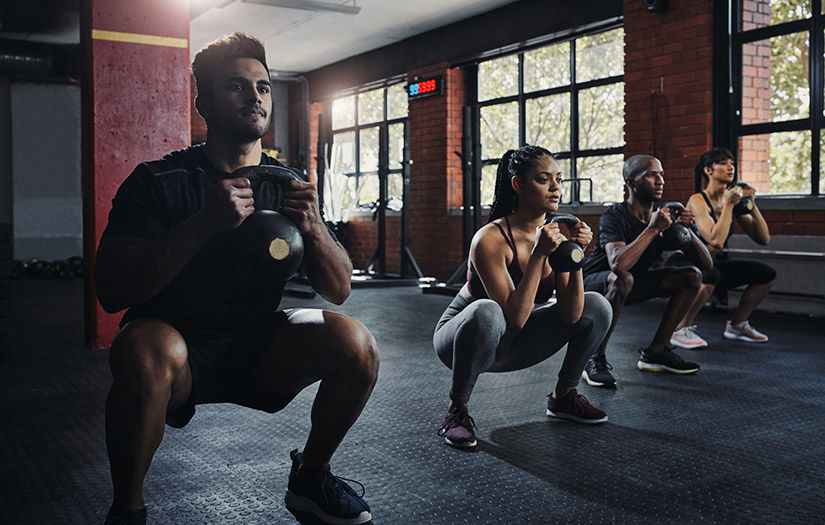By Dana Bender
With the multitude of workouts available on the internet, it can feel overwhelming to get started. Also, beginner exercisers, or those just getting back into it after a break, might not know the best place to start.
During the first stages, it is crucial to set a specific, measurable, attainable, time-specific, and realistic goal compared to a baseline. Ask yourself what you are hoping to accomplish, whether specific to weight loss or strengthening goals.
If you find this content interesting, learn how to design the best at-home workout right here.
BEFORE YOU START A NEW WORKOUT PROGRAM
Before starting a new workout program, it is essential to take a step back, determine personal fitness goals, and consider your baseline. This is all part of the preparation process needed to successfully make a behavioral change, such as starting a new workout program.
If you are preparing to begin a workout program and are just getting back into exercise, it is crucial to maintain the following workout tips:
Make sure you are cleared to exercise – Before beginning any exercise program, it is important that your primary care physician cleared you to exercise. Don’t have a physician? Think about finding one and starting regular annual visits with your primary care physician to prioritize your health and wellbeing. Getting an annual physical is an excellent step towards managing your health and can make it easier to get the “all clear” to begin an exercise program.
Determine your baseline goal – It is important to know what you hope to accomplish by the exercise program. Is your goal related to weight loss or increasing muscular strength and endurance? Make sure to identify your goal before jumping into a schedule so that you maximize your efforts and work efficiently towards your goals. Your goals should be SMART (specific, measurable, attainable, realistic, and time-specific).
Let’s jump into the workouts!
DYNAMIC WARM-UP FOR BEGINNERS
For each workout program, make sure to start with a dynamic warm-up and end with a 5-minute cool-down consisting of passive stretching (30-45 seconds per stretch)
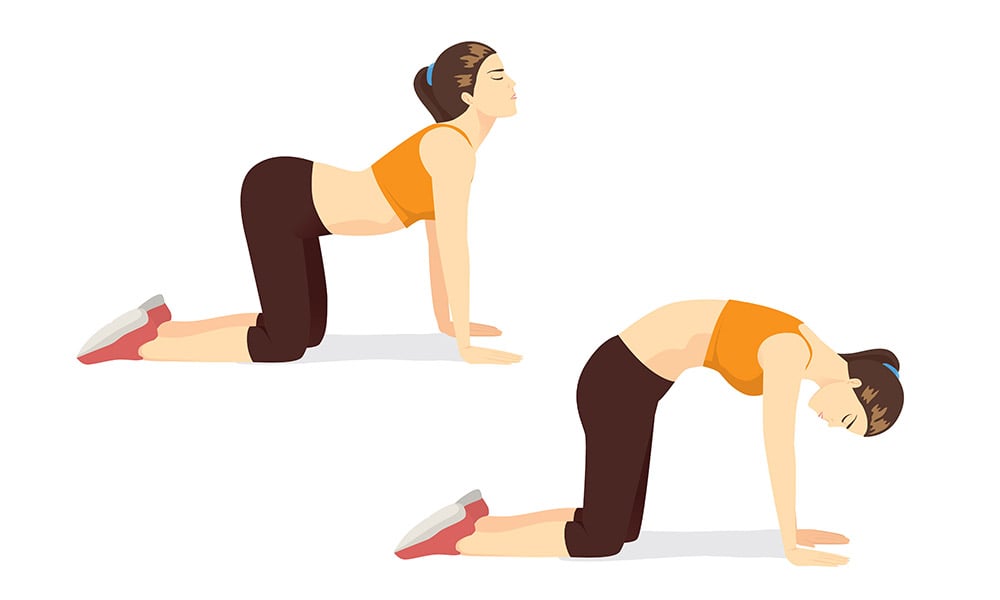
Cat Cow – 2X 10 repetitions
Kneeling plank or full plank (Forearms or hands) – 15-20 seconds or 30 seconds 2x through
Bird Dog Dynamic – 2 sets of 10 repetitions each side
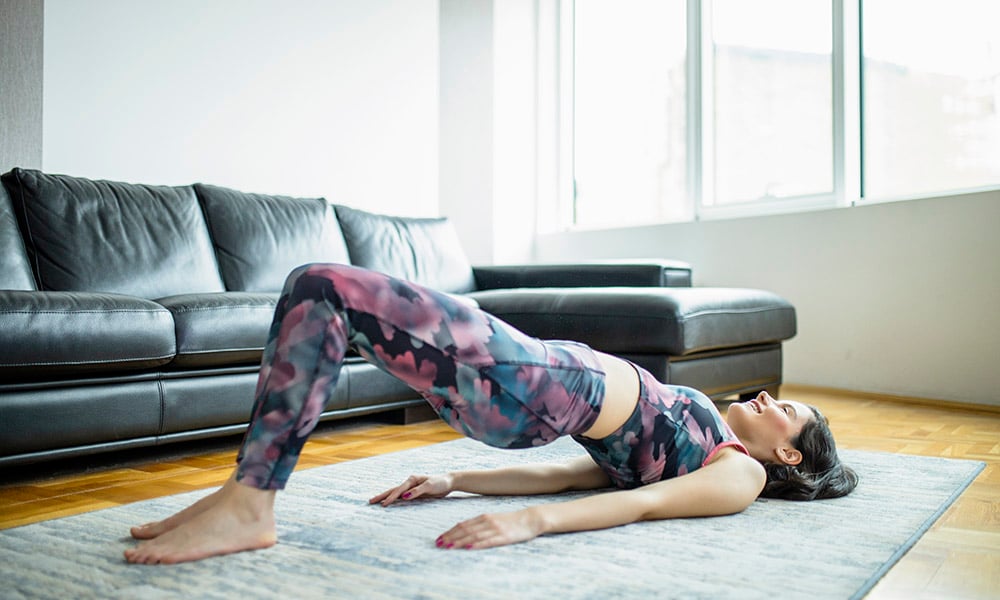
Glute Bridges – 2 sets of 10-12 repetitions
Standing – Arms open/close out in front of the torso
Standing – Arm circles – 5-8x each direction
COOL-DOWN FOR BOTH WORKOUT PROGRAMS:
Standing Quad Stretch – both sides
Standing hamstring stretch – both sides
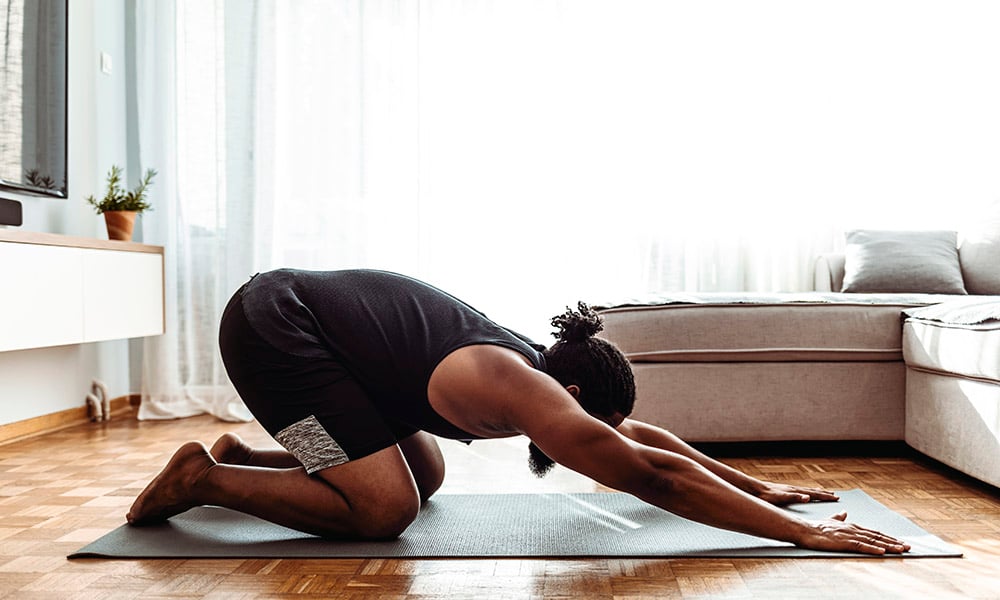
Child’s pose
Lateral child’s pose – both sides
Figure four- glute stretch – both sides
Reclining twist – both sides
Reclining knees to chest
BEGINNER FRIENDLY HOME WORKOUT ROUTINE FOR WEIGHT LOSS (5 WEEKS)
This program starts with 2 days of low-impact cardiovascular exercise and 1 day of full-body resistance training. By the end of the program, you will work up to four active days consisting of both weight training and cardiovascular exercise. At the start of the program, you will rest 4 days and this will reduce to 3 by the end of the 5 weeks.
NOTE: Healthy weight loss is 1-2 lbs. per week and can take time. Once you finish these five weeks, plan to continue this routine and keep working towards your goal.
WEEK 1:
Week Overview: 1 Full body resistance training sessions, two low-impact cardiovascular sessions
Total Active Days: 3 days non-consecutive (I.e. M/W/F or T/TH/SAT)
Total Rest Days: 4 days
Day 1: Full body resistance training session (see program below)
Day 2: Rest
Day 3: Low-impact cardiovascular session (Walk or bike – just get moving) – 15-20 minutes
Day 4: Rest
Day 5: Low-impact cardiovascular session (walk or bike – just get moving!) 15-20 minutes
Day 6&7: Rest days
WEEK 2:
Week Overview: 1 Full body resistance training session, 1 longer low-impact cardiovascular session, 1 Full body resistance training with 1 shorter low-impact cardiovascular session.
Total Active Days: 3 days non-consecutive (I.e. M/W/F or T/TH/SAT)
Total Rest Days: 4 days
Day 1: Full body resistance training session
Day 2: Rest day
Day 3: Low Impact Cardiovascular session (walk or bike) 20-30 minutes
Day 4: Rest day
Day 5: Full-body resistance training AND low-impact cardiovascular session (walk or bike) 15-20 minutes
Day 6&7: Rest days
WEEK 3:
Week Overview: 1 full-body resistance training session, 1 interval moderate cardiovascular session, 1 day both full-body resistance training and low-impact cardiovascular session
Total Active Days: 3 days non-consecutive (I.e. M/W/F or T/TH/SAT)
Total Rest Days: 4 days
Day 1: Full body resistance training session
Day 2: Rest day
Day 3: NEW: Interval Walk – Following a 5-minute warm-up, walk fast or jog 30 seconds; 1-minute moderate pace; repeating this for approximately 20 minutes. Finish with a 5-minute cool-down and passive stretch – (30 minutes)
Day 4: Rest day
Day 5: Full body resistance training + low impact cardiovascular (20-30 minutes) session
Day 6 & 7: Rest days
WEEK 4 & 5:
Week overview: 1 Full-body resistance training, 1 Full-body resistance training with low-impact cardiovascular exercise session; 1 interval cardiovascular session, 1 day low-impact cardiovascular exercise
Total Active Days: 4 days
Total Rest Days: 3 days
Day 1: Full-body resistance training and low impact cardiovascular (20-30 minutes) session
Day 2: Rest day
Day 3: Interval Walk or Walk/Jog session – Following a 5-minute warm-up, walk fast or jog 30 seconds; 1 minute moderate pace; repeating this for approximately 20 minutes. Finish with a 5-minute cooldown and passive stretch (30 minutes)
Day 4: Rest day
Day 5: Full body resistance training session
Day 6: Low-impact cardiovascular session (20 – 30 minutes)
Day 7: Rest day
FULL BODY AT-HOME STRENGTH ROUTINE FOR WEIGHT-LOSS:
Prescription: 2-3 sets of 12-15 repetitions; 30 seconds rest in between sets
Equipment needed: set of light-medium weights
Bodyweight or Squats holding weights

Stationary Lunges on each side
Alternating lunges on each side
Push-ups (Modified with knees on the ground, hips forward, abdomen engaged)
Bent-over Rows with weights
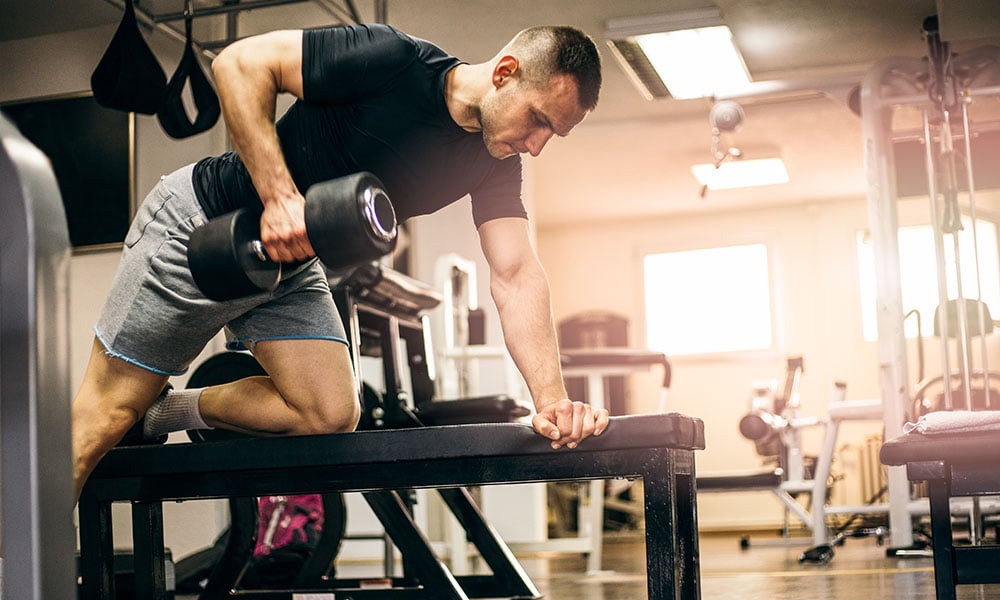
Squat into shoulder Press
Forearm Plank (modified with knees on the ground or full plank)
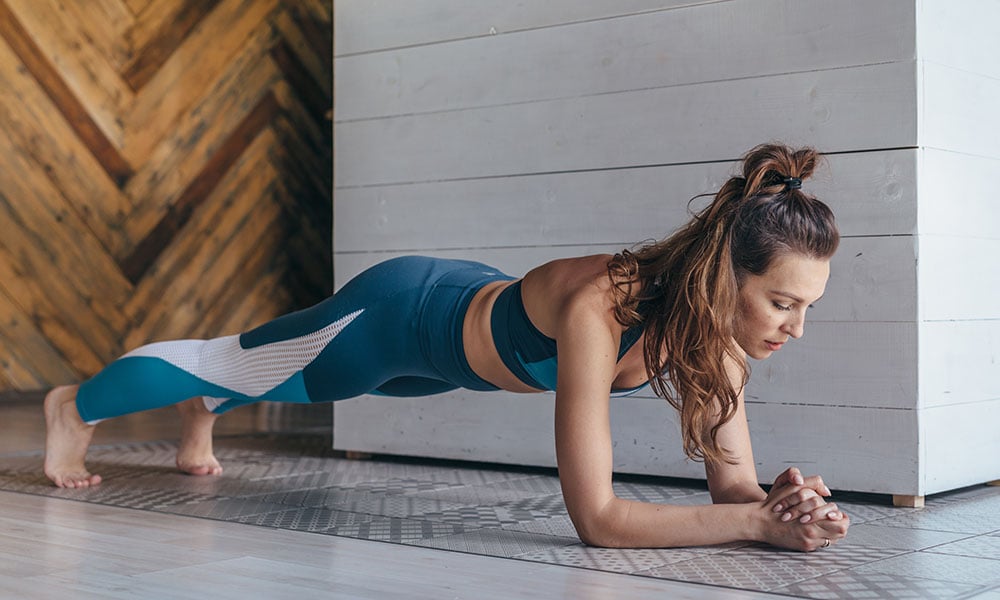
Kneeling Side Plank (modified with knees on the ground) on each side
Supermans
Russian Twists
Glute Bridges
Dead bug Exercise
5-WEEK AT-HOME WORKOUT ROUTINE FOR MUSCLE GROWTH:
This program starts with 2 days of full-body resistance training and one day of low-impact cardiovascular exercise and works up to 3 days a week of resistance training (split into lower-body, full-body, and upper-body and core sessions), and 2-3 cardiovascular sessions per week.
At the start of the program you will rest 4 days and this will reduce to 3 by the end of the 5 weeks.
WEEK 1:
Week overview: 2 Full-body resistance training sessions, 1 low-impact cardiovascular session
Total Active Days: 3 days non-consecutive (I.e. M/W/F or T/TH/SAT)
Total Rest Days: 4 days
Day 1: Full body resistance training session (see program below)
Day 2: Rest day
Day 3: Low-impact cardiovascular session (Walk or bike – just get moving) – 15-20 minutes
Day 4: Rest day
Day 5: Full body resistance training session (see program below)
Day 6&7: Rest days
WEEK 2:
Week overview: 2 Full-body resistance training sessions, 2 days low-impact cardiovascular sessions
Total Active Days: 3 days non-consecutive (I.e. M/W/F or T/TH/SAT)
Total Rest Days: 4 days
Day 1: Full body resistance training session
Day 2: Rest day
Day 3: Low impact cardiovascular session (walk or bike) 20-30 minutes
Day 4: Rest day
Day 5: Full body resistance training session AND low-impact cardiovascular session (walk or bike) 15-20 minutes
Day 6&7: Rest days
WEEK 3:
Week overview: 1 Full-body resistance training session, 1 upper-body and core session combined with a low-impact cardiovascular session; 1 lower-body session combined with a low-impact cardiovascular session.
Total Active Days: 3 days non-consecutive (I.e. M/W/F or T/TH/SAT)
Total Rest Days: 4 days
Day 1: Lower Body resistance training and low impact cardio (20 minutes) session
Day 2: Rest day
Day 3: Full body resistance training session
Day 4: Rest day
Day 5: Upper body+ core resistance training and low impact cardio (20 minutes) session
Day 6 & 7: Rest days
WEEK 4 & 5:
3 days resistance training (1 lower-body, 1 upper-body, and 1 full-body); 2-3 days low impact cardiovascular sessions; 1-day interval walk or interval walk/jog session
Week overview: 3 days resistance training; 2 low-impact cardiovascular exercise
Total Active Days: 4 days
Total Rest Days: 3 days
Day 1: Lower Body resistance training + low impact cardio (20-30 minutes) session
Day 2: Rest day
Day 3: Full body resistance training session
Day 4: Rest day
Day 5: Upper body + core resistance training session + optional low impact cardiovascular session (20-30 minutes)
Day 6: Low impact cardiovascular session (30 minutes)
Day 7: Rest day
FULL BODY AT-HOME STRENGTH ROUTINE FOR MUSCLE GROWTH
*This program can be split up into lower-body and upper-body and core starting week 3.
Prescription: 3-4 sets of 8-10 repetitions; 30-45 seconds rest between sets
Equipment needed: set of light-medium weights
Lower Body – Bodyweight Squats (add weights if available weeks 3-5)
Lower Body – Stationary Lunges each side (transition to alternating lunges weeks 3-5)
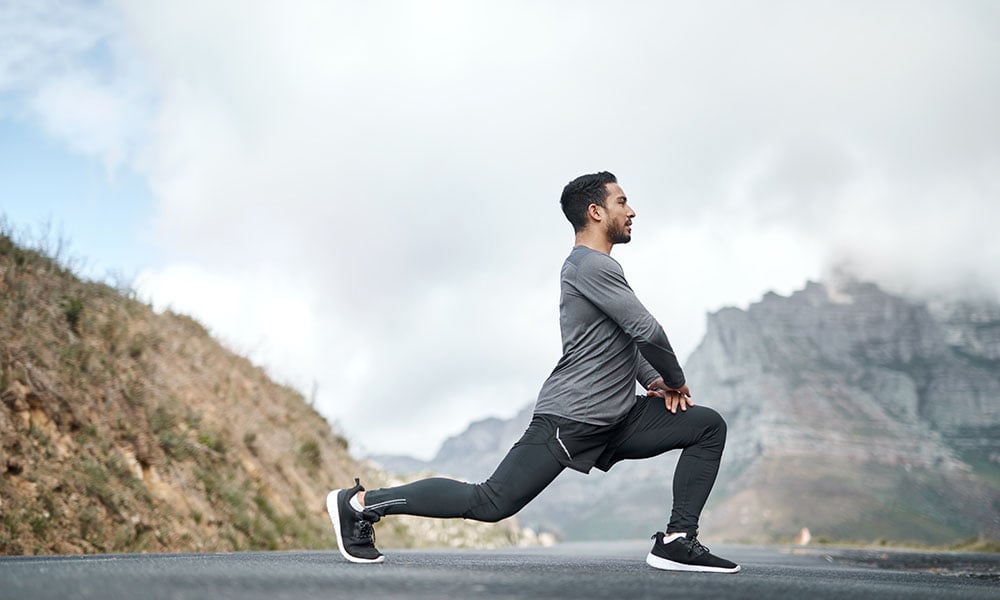
Lower Body – Alternating Lunges each side
Lower Body – Wall Sit – start with 15-20 seconds – build to 30 seconds

Lower Body – Glute Bridges
Lower Body – Standing Calf Raises
Upper Body – Push-ups (Modified with knees on the ground, hips forward, abdomen engaged – work up to full pushups when able)
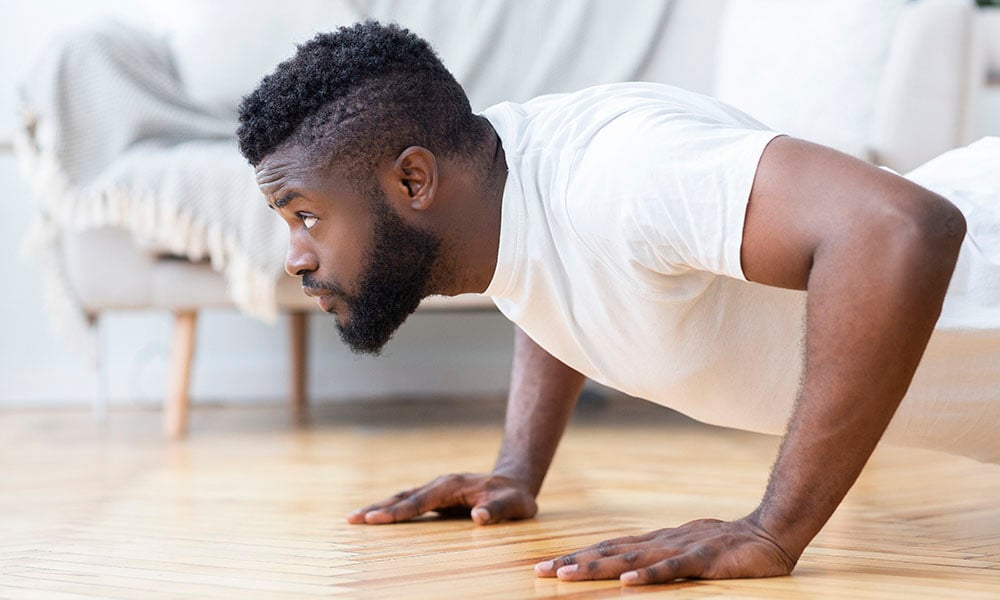
Upper Body – Bent over Rows with weights
Upper Body – Squat into shoulder Press
Upper Body – Triceps Kickbacks
Core – Forearm Plank (modified with knees on the ground or full plank)
*Note: This prescription will be slightly different. Perform this exercise for 2x 30-second hold each
Core – Kneeling Side Plank Hip Lifts/Lowers (modified with knees on the ground)
Core – Russian Twists
Core – Dead bug Exercise
5 ADDITIONAL TIPS FOR BEGINNER’S WORKOUTS
- Don’t do too much too soon – It is common for beginner exercisers to start running before implementing a walking program or lift heavier weights versus starting with lighter weights. Keep in mind that it’s important not to do too much too soon since it increases the risk of injury and can harm exercise adherence. Try not to rush the process. Remember, strength and performance builds over time.
- Incorporate a warm-up and cool-down – For both resistance training and cardiovascular workouts, start with a 5-minute warm-up, and end with a 5-minute cool-down. Both a cool-down and a warm-up are needed steps regardless of fitness level. Warm up by walking in place or on a treadmill and/ or biking slowly to get the body temperature to rise. A good recommendation for a cool down is to perform simple movements or walking slowly following more intense movement to bring the heart rate back down to homeostasis. Additionally, as part of a cool-down, perform passive stretching for each major muscle group worked, holding each stretch 30-45 seconds each. This can help with muscle recovery.
- Know your limits & pay attention – When you start an exercise program, know your limits physically, and stay aware of past injuries you need to be mindful of. Also, pay attention while performing each exercise of the program. It is essential to listen to your body for any indication you might be pushing yourself too much. For example, make sure you can still speak at least 3-5 words per breath while doing cardiovascular exercise, and stop immediately if you feel pain or if you experience any of the warning signs of exercises (dizziness or lightheadedness, chest pain, nausea, trouble breathing, etc.)
- Find enjoyment – Starting something new can be challenging, and starting something new is more difficult if you don’t find enjoyment in the process. There are a few recommended strategies to help increase enjoyment while starting an exercise program. First, pick a cardiovascular low to moderate exercise type that you enjoy. For example, do you love to dance? Consider a beginner dance class in place of a walking or biking routine. Secondly, focus on enjoying the process instead of focusing on the end destination. Lastly and most importantly, notice how good it feels to move your body more regularly.
- Don’t forget to rest and recover – Whenever exercise is part of a weekly routine, whether you are a beginner or not; it is essential to remember that rest is just as important as the training itself. Ensure that you incorporate the right balance between active days and rest days (possibly using the sample workout programs shown below). Also, consider performing gentle stretching on your rest days if you are sore from the new routine.
ACSM recommends performing at least two weight training sessions per week, working all of the major muscle groups, and performing moderate-intensity cardiovascular exercise 5 days per week; minimum of 30 minutes each exercise session. The five days can be a mixture of different low to moderate-intensity activities.
The goal is to get moving. For beginner exercisers looking to incorporate more cardiovascular exercise into their routine for general fitness, great options include walking, biking, and swimming. Suppose you currently walk, and that is your baseline. In that case, you might even consider a combination of walking and jogging, making sure to stay within the low to moderate-intensity zone.
When beginning any program, regardless if you are a beginner or are a seasoned exerciser, it is important to stay mindful of nutritional and hydration needs. Drink water before, during, and active exercise, eat two hours before an exercise session and eat a diet consisting of whole foods, complex carbohydrates (fruits, vegetables, whole grains), and lean proteins.
If possible, eat 3-5 healthy, smaller meals throughout the day to make sure you have fuel. Lastly, reduce processed foods, sugary drinks, and sweets. Remember, reaching fitness goals requires a combination of regular and continuous movement with proper nutrition.
THE AUTHOR
DANA BENDER
Dana Bender, MS, NBC-HWC, ACSM, E-RYT. Dana Bender works as a fitness and wellness Program Manager for HealthFitness in Chicago. Dana is also a National Board Certified Health and Wellness Coach, an Adjunct Professor with Rowan University, an E-RYT 200 hour Registered Yoga Teacher, AFAA Group Exercise Instructor, ACSM Exercise Physiologist, and ACE Personal Trainer. Learn more about Dana at www.danabenderwellness.com.

